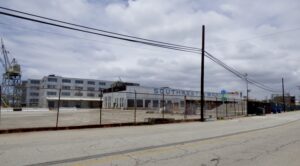SpaceX drops plans for Port of Los Angeles facility again
By Jeff Foust

WASHINGTON — For the second time in less than 18 months, SpaceX has abandoned plans to build a manufacturing facility at the Port of Los Angeles for its next-generation Starship launch vehicle.
In a March 27 letter obtained by SpaceNews, SpaceX notified the Port of Los Angeles that it was terminating a lease approved just a month earlier for a parcel of land at the port. News of the lease termination was first reported by the Los Angeles Times.
The letter, signed by Bret Johnsen, SpaceX’s chief financial officer, served as a 45-day notice of SpaceX’s intent to terminate the lease, making the effective end date of the lease May 11. The letter did not explain why the company was terminating the lease.
The lease was for a property known as Southwest Marine at the port that has been vacant for years. SpaceX originally signed a lease with the port in 2018 to build a factory for a vehicle then known as the Big Falcon Rocket, or BFR. SpaceX said it needed the water access provided by the port property to transport the vehicles, which are too large to move by land to launch sites in Florida or Texas.
SpaceX, though, terminated the lease in early 2019 as part of a company effort to streamline operations that also included layoffs. The company said it would instead manufacture what was now known as Starship, and its Super Heavy booster, at its South Texas test site as well as a facility in Cocoa, Florida, not far from the Kennedy Space Center.
Early this year, SpaceX came back to the Port of Los Angeles, seeking a revised version of its original lease. Rather than build an entirely new facility at the Southwest Marine site, it would instead take an “adaptive reuse” approach for the site, making use of existing buildings there as well as temporary structures like large tents.
“We’re very inspired by that property,” said Matthew Thompson, director of environmental, health and safety at SpaceX, in testimony at a Feb. 20 meeting of the Los Angeles Board of Harbor Commissioners. “We are very interested in developing our operations there and I think it presents a unique opportunity for us based on the previous history of the project, and obviously the water access for some of the plans that we have for the project.”
The board approved the proposed lease on a voice vote at that meeting. The Los Angeles City Council unanimously approved the lease agreement at a Feb. 25 meeting, a little more than a month before the company issued its termination notice.
While Johnsen’s letter gave no reason for SpaceX’s termination of the lease, he said the company was committed to maintaining other operations in California in general, and at the Port of Los Angeles in particular. “SpaceX will continue its operations for recovery of flight-proven rockets and Dragon spacecraft at the Port of Los Angeles,” he wrote.
There is, though, little such activity at the port. The final first-generation Dragon cargo mission, CRS-20, splashed down in the Pacific off the California coast in April, and was returned to the Port of Los Angeles by recovery ships. Future cargo missions, as well as Crew Dragon missions, will instead splash down in the Atlantic. A lack of launch activity from Vandenberg Air Force Base led SpaceX to move a booster recovery droneship to Florida to support a higher cadence of launches there.
The decision to once again terminate the port lease, along with an earlier decision to halt Starship work in Florida, makes South Texas the hub of Starship production work. SpaceX Chief Executive Elon Musk tweeted an aerial photo of that “Starship Production Complex” June 6, a cluster of buildings just down the road from a test site at Boca Chica Beach.
Starship Production Complex
Boca Chica, Texas pic.twitter.com/pd4ka93bv5— Elon Musk (@elonmusk) June 6, 2020
Musk, in a series of tweets, said the company would soon build a “giant high bay” there for stacking the Super Heavy booster. That building will be 81 meters tall, far higher than any other structure currently at the site.
Starship development has, so far, failed to meet the ambitious schedules Musk had set for it. At a media event at the Boca Chica site in late September 2019, he said he expected to begin test flights of the first Starship prototype, Starship Mark 1, in one to two months. “This is going to sound totally nuts, but I think we want to try to reach orbit in less than six months,” he said at the event, a schedule he estimates to be “accurate to within a few months.”
Since then, no Starship prototype has left the ground in powered flight, let alone reach orbit. That Starship Mark 1 prototype was destroyed in a pressurization test in November 2019, and three later prototypes have also been destroyed, most recently in a May 29 explosion after what appeared to be a successful static-fire test.
Despite the setbacks, Musk is maintaining an ambitious schedule for Starship. Asked on Twitter last week if he still had the goal of an uncrewed Mars mission using the vehicle in 2022, followed by a crewed mission in 2024, he offered a one-word response: “Yes.”
June 9, 2020 at 04:16PM
via SpaceNews.com read more...

Post a Comment